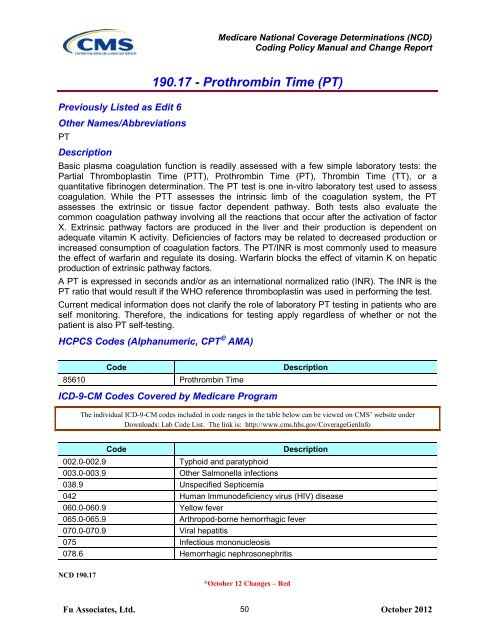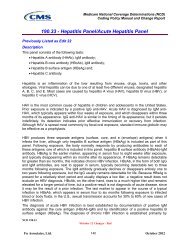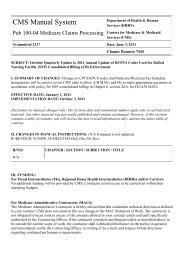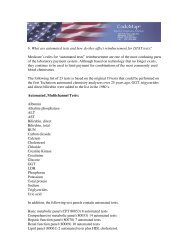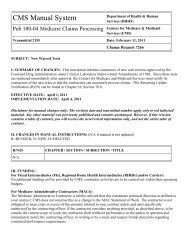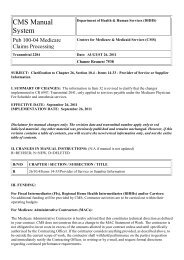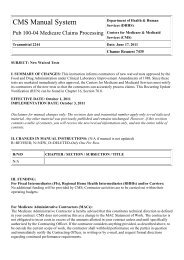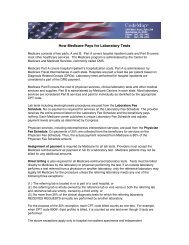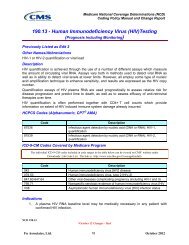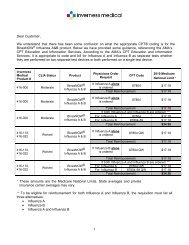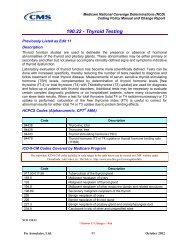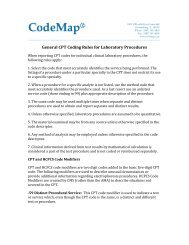NCD 190.17 - CodeMap
NCD 190.17 - CodeMap
NCD 190.17 - CodeMap
Create successful ePaper yourself
Turn your PDF publications into a flip-book with our unique Google optimized e-Paper software.
This is CMS Logo.<br />
Previously Listed as Edit 6<br />
Other Names/Abbreviations<br />
PT<br />
Description<br />
<strong>NCD</strong> <strong>190.17</strong><br />
Medicare National Coverage Determinations (<strong>NCD</strong>)<br />
Coding Policy Manual and Change Report<br />
<strong>190.17</strong> - Prothrombin Time (PT)<br />
Basic plasma coagulation function is readily assessed with a few simple laboratory tests: the<br />
Partial Thromboplastin Time (PTT), Prothrombin Time (PT), Thrombin Time (TT), or a<br />
quantitative fibrinogen determination. The PT test is one in-vitro laboratory test used to assess<br />
coagulation. While the PTT assesses the intrinsic limb of the coagulation system, the PT<br />
assesses the extrinsic or tissue factor dependent pathway. Both tests also evaluate the<br />
common coagulation pathway involving all the reactions that occur after the activation of factor<br />
X. Extrinsic pathway factors are produced in the liver and their production is dependent on<br />
adequate vitamin K activity. Deficiencies of factors may be related to decreased production or<br />
increased consumption of coagulation factors. The PT/INR is most commonly used to measure<br />
the effect of warfarin and regulate its dosing. Warfarin blocks the effect of vitamin K on hepatic<br />
production of extrinsic pathway factors.<br />
A PT is expressed in seconds and/or as an international normalized ratio (INR). The INR is the<br />
PT ratio that would result if the WHO reference thromboplastin was used in performing the test.<br />
Current medical information does not clarify the role of laboratory PT testing in patients who are<br />
self monitoring. Therefore, the indications for testing apply regardless of whether or not the<br />
patient is also PT self-testing.<br />
HCPCS Codes (Alphanumeric, CPT AMA)<br />
Code Description<br />
85610 Prothrombin Time<br />
ICD-9-CM Codes Covered by Medicare Program<br />
The individual ICD-9-CM codes included in code ranges in the table below can be viewed on CMS’ website under<br />
Downloads: Lab Code List. The link is: http://www.cms.hhs.gov/CoverageGenInfo<br />
Code Description<br />
002.0-002.9 Typhoid and paratyphoid<br />
003.0-003.9 Other Salmonella infections<br />
038.9 Unspecified Septicemia<br />
042 Human Immunodeficiency virus (HIV) disease<br />
060.0-060.9 Yellow fever<br />
065.0-065.9 Arthropod-borne hemorrhagic fever<br />
070.0-070.9 Viral hepatitis<br />
075 Infectious mononucleosis<br />
078.6 Hemorrhagic nephrosonephritis<br />
*October 12 Changes – Red<br />
Fu Associates, Ltd. 50 October 2012
This is CMS Logo.<br />
<strong>NCD</strong> <strong>190.17</strong><br />
Medicare National Coverage Determinations (<strong>NCD</strong>)<br />
Coding Policy Manual and Change Report<br />
Code Description<br />
078.7 Arenaviral hemorrhagic fever<br />
084.8 Blackwater fever<br />
120.0 Schistosomiasis<br />
121.1 Clonorchiasis<br />
121.3 Fascioliasis<br />
124 Trichinosis<br />
134.2 Hirudiniasis<br />
135 Sarcoidosis<br />
152.0-152.9 Malignant neoplasm of small intestine, including duodenum<br />
155.0-155.2 Malignant neoplasm of liver and intrahepatic bile ducts<br />
156.0-156.9 Malignant neoplasm of gallbladder and extrahepatic bile ducts<br />
157.0-157.9 Malignant neoplasm of pancreas<br />
188.0-189.9 Malignant neoplasm of bladder, kidney, and other and unspecified<br />
urinary organs<br />
197.7 Secondary malignant neoplasm, liver<br />
198.0 Secondary malignant neoplasm, kidney<br />
198.1 Secondary malignant neoplasm, other urinary organs<br />
200.00-200.28 Lymphosarcoma and reticulosarcoma; Burkitt’s tumor or lymphoma<br />
200.30-200.38 Marginal zone lymphoma<br />
200.40-200.48 Mantle cell lymphoma<br />
200.50-200.58 Primary central nervous system lymphoma<br />
200.60-200.68 Anaplastic large cell lymphoma<br />
200.70-200.78 Large cell lymphoma<br />
200.80-200.88 Malignant tumors of lymphatic tissue; other named variants<br />
202.00-202.68 Other malignant neoplasms of lymphoid and histiocytic tissue<br />
202.70-202.78 Peripheral T-cell lymphoma<br />
202.80-202.98 Other lymphomas; other and unspecified malignant neoplasms of<br />
lymphoid and histiocytic tissue<br />
209.20-209.27, 209.29 Malignant carcinoid tumors of other and unspecified sites<br />
209.70<br />
Secondary neuroendocrine tumor, unspecified site<br />
209.71 Secondary neuroendocrine tumor of distant lymph nodes<br />
209.72 Secondary neuroendocrine tumor of liver<br />
209.73 Secondary neuroendocrine tumor of bone<br />
209.74 Secondary neuroendocrine tumor of peritoneum<br />
209.75 Secondary Merkel cell carcinoma<br />
209.79<br />
Secondary neuroendocrine tumor of other sites<br />
223.0-223.9 Benign neoplasm of kidney and other urinary organs<br />
238.4 Polycythemia vera<br />
238.5 Histocytic and mast cells – neoplasm of uncertain behavior<br />
238.6 Plasma cells – neoplasm of uncertain behavior<br />
238.71 Essential thrombocythemia<br />
238.72 Low grade myelodysplastic syndrome lesions<br />
*October 12 Changes – Red<br />
Fu Associates, Ltd. 51 October 2012
This is CMS Logo.<br />
<strong>NCD</strong> <strong>190.17</strong><br />
Medicare National Coverage Determinations (<strong>NCD</strong>)<br />
Coding Policy Manual and Change Report<br />
Code Description<br />
238.73 High grade myelodysplastic syndrome lesions<br />
238.74 Myelodysplastic syndrome with 5q deletion<br />
238.75 Myelodysplastic syndrome, unspecified<br />
238.76 Myelofibrosis with myeloid metaplasia<br />
238.77 Post-transplant lymphoproliferative disorder (PTLD)<br />
238.79 Other lymphatic and hematopoietic tissues<br />
239.4 Neoplasm of unspecified nature, bladder<br />
239.5 Neoplasm of unspecified nature, other genitourinary organs<br />
239.9 Neoplasm of unspecified nature, site unspecified<br />
246.3 Hemorrhage and infarction of thyroid<br />
249.40 Secondary diabetes mellitus with renal manifestations, not stated as<br />
uncontrolled<br />
249.41 Secondary diabetes mellitus with renal manifestations, uncontrolled<br />
250.40-250.43 Diabetic with renal manifestations<br />
263.0-263.9 Other and unspecified protein/calorie malnutrition<br />
269.0 Deficiency of Vitamin K<br />
269.2 Unspecified vitamin deficiency<br />
273.0-273.3, 273.8-273.9 Disorders of plasma protein metabolism<br />
275.01 Hereditary hemochromatosis<br />
275.02 Hemochromatosis due to repeated red blood cell transfusions<br />
275.03 Other hemochromatosis<br />
275.09 Other disorders of iron metabolism<br />
277.1 Disorders of porphyrin metabolism<br />
277.30 Amyloidosis, unspecified<br />
277.31 Familial Mediterranean fever<br />
277.39 Other amyloidosis<br />
280.0 Iron deficiency anemia, secondary to blood loss - chronic<br />
280.9 Iron deficiency anemia, unspecified<br />
281.0 Pernicious anemia<br />
281.1 Other vitamin B12 deficiency anemia, NEC<br />
281.9 Unspecified deficiency anemia, NOS<br />
285.0 Sideroblastic anemia<br />
285.1 Acute posthemorrhagic anemia<br />
286.0-286.9 Coagulation defects<br />
287.0-287.39 Allergic purpura; qualitative platelet defects; other nonthrombocytopenic<br />
purpuras; primary thrombocytopenia<br />
287.41 Posttransfusion purpura<br />
287.49 Other secondary thrombocytopenia<br />
287.5-287.9 Thrombocytopenia, unspecified; other specified and unspecified<br />
hemorrhagic conditions<br />
289.81 Primary hypercoagulable state<br />
*October 12 Changes – Red<br />
Fu Associates, Ltd. 52 October 2012
This is CMS Logo.<br />
<strong>NCD</strong> <strong>190.17</strong><br />
Medicare National Coverage Determinations (<strong>NCD</strong>)<br />
Coding Policy Manual and Change Report<br />
Code Description<br />
290.40-290.43 Vascular dementia<br />
325 Phlebitis and thrombophlebitis of intracranial venous sinuses<br />
342.90-342.92 Hemiplegia NOS<br />
360.43 Hemophthalmos, except current injury<br />
362.18 Retinal vasculitis<br />
362.30-362.37 Retinal vascular occlusion<br />
362.43 Hemorrhagic detachment of retinal pigment epithelium<br />
362.81 Retinal hemorrhage<br />
363.61-363.72 Choroidal hemorrhage and rupture, detachment<br />
368.9 Unspecified visual disturbances<br />
372.72 Conjunctival hemorrhage<br />
374.81 Hemorrhage of eyelid<br />
376.32 Orbital hemorrhage<br />
377.42 Hemorrhage in optic nerve sheaths<br />
377.53 Disorders of optic chiasm associated with vascular disorders<br />
377.62 Disorders of visual pathways associated with vascular disorders<br />
377.72 Disorders of visual cortex associated with vascular disorders<br />
379.23 Vitreous hemorrhage<br />
380.31 Hematoma of auricle or pinna<br />
386.2 Vertigo of central origin<br />
386.50 Labyrinthine dysfunction, unspecified<br />
394.0-394.9 Diseases of the mitral valve<br />
395.0 Rheumatic aortic stenosis<br />
395.2 Rheumatic aortic stenosis with insufficiency<br />
396.0-396.9 Diseases of mitral and aortic valves<br />
397.0-397.9 Diseases of other endocardial structures<br />
398.0-398.99 Other rheumatic heart disease<br />
403.01, 403.11, 403.91 Hypertensive chronic kidney disease, with chronic kidney disease<br />
stage V or end stage renal disease<br />
404.02, 404.12, 404.92 Hypertensive heart and chronic kidney disease, without heart failure<br />
and with chronic kidney disease stage V or end stage renal disease<br />
410.00-410.92 Acute myocardial infarction<br />
411.1 Intermediate coronary syndrome<br />
411.81 Coronary occlusion without myocardial infarction<br />
411.89 Other acute and subacute forms of ischemic heart disease<br />
413.0-413.9 Angina pectoris<br />
414.00-414.07 Coronary atherosclerosis<br />
414.3 Coronary atherosclerosis due to lipid rich plaque<br />
414.4 Coronary atherosclerosis due to calcified coronary lesion<br />
414.8 Other specified forms of chronic ischemic heart disease<br />
414.9 Chronic ischemic heart disease, unspecified<br />
*October 12 Changes – Red<br />
Fu Associates, Ltd. 53 October 2012
This is CMS Logo.<br />
<strong>NCD</strong> <strong>190.17</strong><br />
Medicare National Coverage Determinations (<strong>NCD</strong>)<br />
Coding Policy Manual and Change Report<br />
Code Description<br />
415.0 – 415.19 Acute pulmonary heart disease<br />
416.9 Chronic pulmonary heart disease, unspecified<br />
423.0 Hemopericardium<br />
424.0 Mitral valve disorders<br />
424.1 Aortic valve disorder<br />
424.90 Endocarditis, valve unspecified, unspecified cause<br />
425.0, 425.11, 425.18,<br />
425.2-425.9<br />
Cardiomyopathy<br />
427.0-427.9 Cardiac dysrhythmias<br />
428.0-428.9 Heart failure<br />
429.0-429.4 Ill-defined descriptions and complications of heart disease<br />
429.79 Other sequelae of myocardial infarction, not elsewhere classified<br />
430 Subarachnoid hemorrhage<br />
431 Intracerebral hemorrhage<br />
432.0-432.9 Other and unspecified intracranial hemorrhage<br />
433.00-433.91 Occlusion and stenosis of precerebral arteries<br />
434.00-434.91 Occlusion of cerebral arteries<br />
435.0-435.9 Transient cerebral ischemia<br />
436 Acute, but ill-defined cerebrovascular disease<br />
437.0 Cerebral atherosclerosis<br />
437.1 Other generalized ischemic cerebrovascular disease<br />
437.6 Nonpyogenic thrombosis of intracranial venous sinus<br />
440.0-440.32 Atherosclerosis of aorta; of other arteries; of bypass grafts<br />
440.4 Chronic total occlusion of artery of the extremities<br />
440.8-440.9 Atherosclerosis of other specified arteries; generalized and<br />
unspecified atherosclerosis<br />
441.0-441.9 Aortic aneurysm and dissection<br />
443.0-443.9 Other peripheral vascular disease<br />
444.01, 444.09, 444.1-444.9 Arterial embolism and thrombosis<br />
447.1 Stricture of artery<br />
447.2 Rupture of artery<br />
447.6 Arteritis, unspecified<br />
448.0 Hereditary hemorrhagic telangiectasia<br />
448.9 Other and unspecified capillary diseases<br />
451.0-451.9 Phlebitis and thrombophlebitis<br />
452 Portal vein thrombosis<br />
453.0 Budd-Chiari syndrome<br />
453.1 Thrombophlebitis migrans<br />
453.2 Embolism and thrombosis of inferior vena cava<br />
453.3 Embolism and thrombosis of renal vein<br />
*October 12 Changes – Red<br />
Fu Associates, Ltd. 54 October 2012
This is CMS Logo.<br />
<strong>NCD</strong> <strong>190.17</strong><br />
Medicare National Coverage Determinations (<strong>NCD</strong>)<br />
Coding Policy Manual and Change Report<br />
Code Description<br />
453.40 Acute venous embolism and thrombosis of unspecified deep vessels<br />
of lower extremity<br />
453.41 Acute venous embolism and thrombosis of deep vessels of proximal<br />
lower extremity<br />
453.42 Acute venous embolism and thrombosis of deep vessels of distal<br />
lower extremity<br />
453.50 Chronic venous embolism and thrombosis of unspecified deep vessels<br />
of lower extremity<br />
453.51 Chronic venous embolism and thrombosis of deep vessels of proximal<br />
lower extremity<br />
453.52 Chronic venous embolism and thrombosis of deep vessels of distal<br />
lower extremity<br />
453.6 Venous embolism and thrombosis of superficial vessels of lower<br />
extremity<br />
453.71 Chronic venous embolism and thrombosis of superficial veins of upper<br />
extremity<br />
453.72 Chronic venous embolism and thrombosis of deep veins of upper<br />
extremity<br />
453.73 Chronic venous embolism and thrombosis of upper extremity,<br />
unspecified<br />
453.74<br />
Chronic venous embolism and thrombosis of axillary veins<br />
453.75<br />
Chronic venous embolism and thrombosis of subclavian veins<br />
453.76<br />
Chronic venous embolism and thrombosis of internal jugular veins<br />
453.77 Chronic venous embolism and thrombosis of other thoracic veins<br />
453.79<br />
Chronic venous embolism and thrombosis of other specified veins<br />
453.81<br />
Acute venous embolism and thrombosis of superficial veins of upper<br />
extremity<br />
453.82<br />
Acute venous embolism and thrombosis of deep veins of upper<br />
453.83<br />
extremity<br />
Acute venous embolism and thrombosis of upper extremity,<br />
unspecified<br />
453.84 Acute venous embolism and thrombosis of axillary veins<br />
453.85 Acute venous embolism and thrombosis of subclavian veins<br />
453.86 Acute venous embolism and thrombosis of internal jugular veins<br />
453.87 Acute venous embolism and thrombosis of other thoracic veins<br />
453.89<br />
Acute venous embolism and thrombosis of other specified veins<br />
453.9 Other venous embolism and thrombosis of unspecified site<br />
455.2 Internal hemorrhoids with other complication<br />
455.5 External hemorrhoids with other complication<br />
455.8 Unspecified hemorrhoids with other complication<br />
456.0-456.1 Esophageal varices<br />
456.8 Varices of other sites<br />
459.0 Hemorrhage, unspecified<br />
459.10-459.19 Postphlebetic syndrome<br />
*October 12 Changes – Red<br />
Fu Associates, Ltd. 55 October 2012
This is CMS Logo.<br />
<strong>NCD</strong> <strong>190.17</strong><br />
Medicare National Coverage Determinations (<strong>NCD</strong>)<br />
Coding Policy Manual and Change Report<br />
Code Description<br />
459.2 Compression of vein<br />
459.81 Venous (peripheral) insufficiency, unspecified<br />
459.89 Other, other specified disorders of circulatory system<br />
511.81 Malignant pleural effusion<br />
511.89 Other specified forms of effusion, except tuberculosis<br />
514 Pulmonary congestion and hypostasis<br />
530.7 Gastroesophageal laceration - hemorrhage syndrome<br />
530.82 Esophageal hemorrhage<br />
530.86 Infection of esophagostomy<br />
530.87 Mechanical complication of esophagostomy<br />
531.00-535.61 Gastric ulcer, duodenal ulcer, peptic ulcer, gastrojejunal ulcer, gastritis<br />
and duodenitis<br />
535.70 Eosinophilic gastritis, without mention of obstruction<br />
535.71 Eosinophilic gastritis, with obstruction<br />
555.0-555.9 Regional enteritis<br />
556.0-556.9 Ulcerative colitis<br />
557.0-557.9 Vascular insufficiency of intestine<br />
562.02-562.03 Diverticulosis of small intestine with hemorrhage<br />
562.10 Diverticulosis of colon w/o hemorrhage<br />
562.11 Diverticulitis of colon w/o hemorrhage<br />
562.12 Diverticulosis of colon with hemorrhage<br />
562.13 Diverticulitis of colon with hemorrhage<br />
568.81 Hemoperitoneum (nontraumatic)<br />
569.3 Hemorrhage of rectum and anus<br />
571.0-571.9 Chronic liver disease and cirrhosis<br />
572.2 Hepatic encephalopathy<br />
572.4 Hepatorenal syndrome<br />
572.8 Other sequelae of chronic liver disease<br />
573.1-573.9 Hepatitis in viral diseases, other and unspecified disorder of liver<br />
576.0-576.9 Other disorders of Biliary tract<br />
577.0 Acute pancreatitis<br />
578.0-578.9 Gastrointestinal hemorrhage<br />
579.0-579.9 Intestinal Malabsorption<br />
581.0-581.9 Nephrotic Syndrome<br />
583.9 Nephritis, with unspecified pathological lesion in kidney<br />
584.5<br />
Acute kidney failure with lesion of tubular necrosis<br />
584.6<br />
Acute kidney failure with lesion of renal cortical necrosis<br />
584.7 Acute kidney failure with lesion of renal medullary (papillary) necrosis<br />
584.8 Acute kidney failure with other specified pathological lesion in kidney<br />
584.9 Acute kidney failure, unspecified<br />
*October 12 Changes – Red<br />
Fu Associates, Ltd. 56 October 2012
This is CMS Logo.<br />
<strong>NCD</strong> <strong>190.17</strong><br />
Medicare National Coverage Determinations (<strong>NCD</strong>)<br />
Coding Policy Manual and Change Report<br />
Code Description<br />
585.4-585.9 Chronic kidney disease<br />
586 Renal failure, unspecified<br />
593.81-593.89 Other specified disorders of kidney and ureter<br />
596.7 Hemorrhage into bladder wall<br />
596.81 Infection of cystostomy<br />
596.82 Mechanical complication of cystostomy<br />
596.83 Other complication of cystostomy<br />
596.89 Other specified disorders of bladder<br />
599.70 Hematuria, unspecified<br />
599.71 Gross hematuria<br />
599.72 Microscopic hematuria<br />
607.82 Vascular disorders of penis<br />
608.83 Vascular disorders of male genital organs<br />
611.89 Other specified disorders of breast including hematoma<br />
620.7 Hematoma of broad ligament<br />
621.4 Hematometra<br />
622.8 Other specified noninflammatory disorders of cervix<br />
623.6 Vaginal hematoma<br />
623.8 Other specified noninflammatory disorders of the vagina<br />
624.5 Hematoma of vulva<br />
626.2-626.9 Abnormal bleeding from female genital tract<br />
627.0 Premenopausal menorrhagia<br />
627.1 Postmenopausal bleeding<br />
629.0 Hematocele female, not classified elsewhere<br />
632 Missed abortion<br />
634.10-634.12 Spontaneous abortion, complicated by excessive hemorrhage<br />
635.10-635.12 Legally induced abortion, complicated by delayed or excessive<br />
hemorrhage<br />
636.10-636.12 Illegally induced abortion, complicated by delayed or excessive<br />
hemorrhage<br />
637.10-637.12 Abortion unspecified, complicated by delayed or excessive<br />
hemorrhage<br />
638.1 Failed attempted abortion, complicated by delayed or excessive<br />
hemorrhage<br />
639.1 Delayed or excessive hemorrhage following abortion and ectopic and<br />
molar pregnancies<br />
639.6 Complications following abortion and ectopic and molar pregnancies<br />
with embolism<br />
640.00-640.93 Hemorrhage in early pregnancy<br />
641.00-641.93 Antepartum hemorrhage, abruptio placentae, and placenta previa<br />
642.00-642.94 Hypertension complicating pregnancy, childbirth, and the puerperium<br />
646.70-646.73 Liver disorders in pregnancy<br />
*October 12 Changes – Red<br />
Fu Associates, Ltd. 57 October 2012
This is CMS Logo.<br />
<strong>NCD</strong> <strong>190.17</strong><br />
Medicare National Coverage Determinations (<strong>NCD</strong>)<br />
Coding Policy Manual and Change Report<br />
Code Description<br />
649.30 Coagulation defects complicating pregnancy, childbirth, or the<br />
puerperium, unspecified as to episode of care or not applicable<br />
649.31 Coagulation defects complicating pregnancy, childbirth, or the<br />
puerperium, delivered, with or without mention of antepartum condition<br />
649.32 Coagulation defects complicating pregnancy, childbirth, or the<br />
puerperium, delivered, with mention of postpartum complication<br />
649.33 Coagulation defects complicating pregnancy, childbirth, or the<br />
puerperium, antepartum condition or complication<br />
649.34 Coagulation defects complicating pregnancy, childbirth, or the<br />
puerperium, postpartum condition or complication<br />
649.50 Spotting complicating pregnancy, unspecified as to episode of care or<br />
not applicable<br />
649.51 Spotting complicating pregnancy, delivered, with or without mention of<br />
antepartum condition<br />
649.53 Spotting complicating pregnancy, antepartum condition or complication<br />
656.00-656.03 Fetal maternal hemorrhage<br />
658.40-658.43 Infection of amniotic cavity<br />
666.00-666.34 Postpartum hemorrhage<br />
671.20-671.94 Venous complications in pregnancy and the puerperium except legs,<br />
vulva and perineum<br />
673.00-673.84 Obstetrical pulmonary embolism<br />
674.30-674.34 Other complications of obstetrical surgical wounds<br />
713.2 Arthropathy associated with hematological disorders<br />
713.6 Arthropathy associated with hypersensitivity reaction<br />
719.15 Hemarthrosis pelvic region and thigh<br />
719.16 Lower leg<br />
719.19 Multiple sites<br />
729.5 Pain in limb<br />
729.81 Swelling of limb<br />
733.10 Pathologic fracture, unspecified site<br />
746.00-746.9 Other Congenital anomalies of heart<br />
762.1 Other forms of placental separation and hemorrhage<br />
767.0, 767.11 Birth trauma, subdural and cerebral hemorrhage and injury to scalp<br />
767.8 Other specified birth trauma<br />
770.3 Pulmonary hemorrhage<br />
772.0 Fetal blood loss affecting newborn<br />
772.10-772.14 Fetal and neonatal intraventricular hemorrhage<br />
772.2 Fetal and neonatal subarachnoid hemorrhage<br />
772.3 Fetal and neonatal umbilical hemorrhage after birth<br />
772.4 Fetal and neonatal gastrointestinal hemorrhage<br />
772.5 Fetal and neonatal adrenal hemorrhage<br />
772.6 Fetal and neonatal cutaneous hemorrhage<br />
772.8 Fetal and neonatal other specified hemorrhage of fetus or newborn<br />
*October 12 Changes – Red<br />
Fu Associates, Ltd. 58 October 2012
This is CMS Logo.<br />
<strong>NCD</strong> <strong>190.17</strong><br />
Medicare National Coverage Determinations (<strong>NCD</strong>)<br />
Coding Policy Manual and Change Report<br />
Code Description<br />
772.9<br />
Fetal and neonatal unspecified hemorrhage of newborn<br />
774.6 Unspecified fetal and neonatal jaundice<br />
776.0 Hemorrhagic disease of the newborn<br />
776.1 Transient neonatal thrombocytopenia<br />
776.2 Disseminated intravascular coagulation in newborn<br />
776.3 Other transient neonatal disorders of coagulation<br />
776.4 Polycythemia neonatorum<br />
776.5 Congenital anemia<br />
776.6 Anemia of prematurity<br />
776.7 Transient neonatal neutropenia<br />
776.8 Other specified transient hematological disorders<br />
776.9 Unspecified hematological disorder specific to newborn<br />
780.2 Syncope and collapse<br />
782.3 Edema<br />
782.4 Jaundice, unspecified, not of newborn<br />
782.7 Spontaneous ecchymosis<br />
784.7 Epistaxis<br />
784.8 Hemorrhage from throat<br />
785.4 Gangrene<br />
785.50 Shock without mention of trauma<br />
786.05 Shortness of breath<br />
786.30 Hemoptysis, unspecified<br />
786.31 Acute idiopathic pulmonary hemorrhage in infants (AIPHI)<br />
786.39 Other hemoptysis<br />
786.50 Chest pain, unspecified<br />
786.51 Precordial pain<br />
786.59 Chest pain, other<br />
789.00-789.09 Abdominal pain<br />
789.1 Hepatomegaly<br />
789.51 Malignant ascites<br />
789.59 Other ascites<br />
789.7 Colic<br />
790.92 Abnormal coagulation profile<br />
790.94 Euthyroid sick syndrome<br />
791.2 Hemoglobinuria<br />
794.8 Abnormal Liver Function Study<br />
800.00-800.99 Fracture of vault of skull<br />
801.00-801.99 Fracture of base of skull<br />
802.20-802.9 Fracture of face bones<br />
803.00-803.99 Other and unqualified skull fractures<br />
804.00-804.99 Multiple fractures involving skull or face with other bones<br />
*October 12 Changes – Red<br />
Fu Associates, Ltd. 59 October 2012
This is CMS Logo.<br />
<strong>NCD</strong> <strong>190.17</strong><br />
Medicare National Coverage Determinations (<strong>NCD</strong>)<br />
Coding Policy Manual and Change Report<br />
Code Description<br />
805.00-806.9 Fracture, vertebral column<br />
807.00-807.09 Fractures of rib(s), closed<br />
807.10-807.19 Fracture of rib(s), open<br />
808.8-808.9 Unspecified fracture of pelvis<br />
809.0-809.1 Ill-defined fractures of bones of trunk<br />
810.00-810.13 Fracture of clavicle<br />
811.00-811.19 Fracture of scapula<br />
812.00-812.59 Fracture of humerus<br />
813.10-813.18 Fracture of radius and ulna, upper end, open<br />
813.30-813.33 Shaft, open<br />
813.50-813.54 Lower end, open<br />
813.90-813.93 Fracture unspecified part, open<br />
819.0-819.1 Multiple fractures involving both upper limbs, closed and open<br />
820.00-821.39 Fracture of neck of femur<br />
823.00-823.92 Fracture of tibia and fibula<br />
827.0-829.1 Other multiple lower limb<br />
852.00-853.19 Subarachnoid subdural, and extradural hemorrhage, following injury,<br />
Other and specified intracranial hemorrhage following injury<br />
860.0-860.5 Traumatic pneumothorax and hemothorax<br />
861.00-861.32 Injury to heart and lung<br />
862.0-862.9 Injury to other and unspecified intrathoracic organs<br />
863.0-863.90 Injury to gastrointestinal tract<br />
863.91-863.95, 863.99 Adding to Injury to gastrointestinal tract<br />
864.00-864.19 Injury to liver<br />
865.00-865.19 Injury to spleen<br />
866.00-866.13 Injury to kidney<br />
867.0-867.9 Injury to pelvic organs<br />
868.00-868.19 Injury to other intra-abdominal organs<br />
869.0-869.1 Internal injury to unspecified or ill defined organs<br />
900.00-900.9 Injury to blood vessels of head and neck<br />
901.0-901.9 Injury to blood vessels of the thorax<br />
902.0-902.9 Injury to blood vessels of the abdomen and pelvis<br />
903.00-903.9 Injury to blood vessels of upper extremity<br />
904.0-904.9 Injury to blood vessels of lower extremity and unspecified sites<br />
920-924.9 Contusion with intact skin surface<br />
925.1-929.9 Crushing injury<br />
958.2 Secondary and recurrent hemorrhage<br />
959.9 Injury, unspecified site<br />
964.0-964.9 Poisoning by agents primarily affecting blood constituents<br />
980.0-980.9 Toxic effect of alcohol<br />
981 Toxic effect of petroleum products<br />
*October 12 Changes – Red<br />
Fu Associates, Ltd. 60 October 2012
This is CMS Logo.<br />
<strong>NCD</strong> <strong>190.17</strong><br />
Medicare National Coverage Determinations (<strong>NCD</strong>)<br />
Coding Policy Manual and Change Report<br />
Code Description<br />
982.0-982.8 Toxic effects of solvents other than petroleum-based<br />
987.0-987.9 Toxic effect of other gases, fumes or vapors<br />
989.0-989.9 Toxic effect of other substances chiefly non-medicinal as to source<br />
995.20 Unspecified adverse effect of unspecified drug, medicinal and<br />
biological substance<br />
995.21 Arthus phenomenon<br />
995.24 Failed moderate sedation during procedure<br />
995.27 Other drug allergy<br />
995.29 Unspecified adverse effect of other drug, medicinal & biological substance<br />
996.82 Complication of transplanted liver<br />
997.02 Iatrogenic cerebrovascular infarction or hemorrhage<br />
997.41 Retained cholelithiasis following cholecystectomy<br />
997.49 Other digestive system complications<br />
998.11-998.12 Hemorrhage or hematoma complicating a procedure<br />
999.2 Other vascular complications<br />
999.80 Transfusion reaction, unspecified<br />
999.83 Hemolytic transfusion reaction, incompatibility unspecified<br />
999.84 Acute hemolytic transfusion reaction, incompatibility unspecified<br />
999.85 Delayed hemolytic transfusion reaction, incompatibility unspecified<br />
999.89 Other transfusion reaction<br />
V08 Asymptomatic HIV infection<br />
V12.1 History of nutritional deficiency<br />
V12.3 Personal history of diseases of blood and blood-forming organs<br />
V12.50-V12.55, V12.59 Personal history of transient ischemic attack, cerebral infarction, or<br />
pulmonary embolism without residual deficits<br />
V15.1 Personal history of surgery to heart and great vessels<br />
V15.21 Personal history of undergoing in utero procedure during pregnancy<br />
V15.22 Personal history of undergoing in utero procedure while a fetus<br />
V15.29 Surgery to other organs<br />
V42.0 Kidney replaced by transplant<br />
V42.1 Heart replaced by transplant<br />
V42.2 Heart valve replaced by transplant<br />
V42.6 Lung replaced by transplant<br />
V42.7 Liver replaced by transplant<br />
V42.81-V42.89 Other specified organ or tissue replaced by transplant<br />
V43.21-V43.22 Heart replaced by other means<br />
V43.3 Heart valve replaced by other means<br />
V43.4 Blood vessel replaced by other means<br />
V58.2 Transfusion of blood products<br />
V58.61 Long-term (current) use of anticoagulants<br />
V58.83 Encounter for therapeutic drug monitoring<br />
*October 12 Changes – Red<br />
Fu Associates, Ltd. 61 October 2012
This is CMS Logo.<br />
Indications<br />
<strong>NCD</strong> <strong>190.17</strong><br />
Medicare National Coverage Determinations (<strong>NCD</strong>)<br />
Coding Policy Manual and Change Report<br />
1. A PT may be used to assess patients taking warfarin. The PT is generally not useful in<br />
monitoring patients receiving heparin who are not taking warfarin.<br />
2. A PT may be used to assess patients with signs or symptoms of abnormal bleeding or<br />
thrombosis. For example:<br />
Swollen extremity with or without prior trauma<br />
Unexplained bruising<br />
Abnormal bleeding, hemorrhage or hematoma<br />
Petechiae or other signs of thrombocytopenia that could be due to Disseminated Intravascular<br />
Coagulation<br />
3. A PT may be useful in evaluating patients who have a history of a condition known to<br />
be associated with the risk of bleeding or thrombosis that is related to the extrinsic<br />
coagulation pathway. Such abnormalities may be genetic or acquired. For example:<br />
Dysfibrinogenemia<br />
Afibrinogenemia (complete)<br />
Acute or chronic liver dysfunction or failure, including Wilson’s disease and Hemochromatosis<br />
Disseminated intravascular coagulation (DIC)<br />
Congenital and acquired deficiencies of factors II, V, VII, X<br />
Vitamin K deficiency<br />
Lupus erythematosus<br />
Hypercoagulable state<br />
Paraproteinemia<br />
Lymphoma<br />
Amyloidosis<br />
Acute and chronic leukemias<br />
Plasma cell dyscrasia<br />
HIV infection<br />
Malignant neoplasms<br />
Hemorrhagic fever<br />
Salicylate poisoning<br />
Obstructive jaundice<br />
Intestinal fistula<br />
Malabsorption syndrome<br />
Colitis<br />
Chronic diarrhea<br />
Presence of peripheral venous or arterial thrombosis or pulmonary emboli or myocardial infarction<br />
*October 12 Changes – Red<br />
Fu Associates, Ltd. 62 October 2012
This is CMS Logo.<br />
<strong>NCD</strong> <strong>190.17</strong><br />
Patients with bleeding or clotting tendencies<br />
Organ transplantation<br />
Medicare National Coverage Determinations (<strong>NCD</strong>)<br />
Coding Policy Manual and Change Report<br />
Presence of circulating coagulation inhibitors<br />
4. A PT may be used to assess the risk of hemorrhage or thrombosis in patients who are<br />
going to have a medical intervention known to be associated with increased risk of<br />
bleeding or thrombosis. For example:<br />
Limitations<br />
Evaluation prior to invasive procedures or operations of patients with personal<br />
history of bleeding or a condition associated with coagulopathy.<br />
Prior to the use of thrombolytic medication<br />
1. When an ESRD patient is tested for PT, testing more frequently than weekly requires<br />
documentation of medical necessity, e.g., other than chronic renal failure or renal<br />
failure unspecified.<br />
2. The need to repeat this test is determined by changes in the underlying medical<br />
condition and/or the dosing of warfarin. In a patient on stable warfarin therapy, it is<br />
ordinarily not necessary to repeat testing more than every two to three weeks. When<br />
testing is performed to evaluate a patient with signs or symptoms of abnormal bleeding<br />
or thrombosis and the initial test result is normal, it is ordinarily not necessary to repeat<br />
testing unless there is a change in the patient’s medical status.<br />
3. Since the INR is a calculation, it will not be paid in addition to the PT when expressed<br />
in seconds, and is considered part of the conventional PT test.<br />
4. Testing prior to any medical intervention associated with a risk of bleeding and<br />
thrombosis (other than thrombolytic therapy) will generally be considered medically<br />
necessary only where there are signs or symptoms of a bleeding or thrombotic<br />
abnormality or a personal history of bleeding, thrombosis or a condition associated with<br />
a coagulopathy. Hospital/clinic-specific policies, protocols, etc., in and of themselves,<br />
cannot alone justify coverage.<br />
ICD-9-CM Codes That Do Not Support Medical Necessity<br />
Any ICD-9-CM code not listed in either of the ICD-9-CM covered or non-covered sections.<br />
Sources of Information<br />
CMD Clinical Laboratory Workgroup<br />
1999 CPT Physicians’ Current Procedural Terminology, American Medical Association<br />
Wintrobe’s Clinical Hematology 9th Ed. Lea and Febinger<br />
Harrison’s Principles of Internal Medicine, McGraw Hill, 14th Ed., 1997.<br />
Diagnostic Tests Handbook, Springhouse Corporation, 1987.<br />
Hemostasis and Thrombosis: Basic Principles and Clinical Practice. Colman, et al editors, J.B.<br />
Lippincott, 3rd Edition, 1994, pp 896-898 and 1045-1046.<br />
Disorders of Hemostasis, Ratnoff, Oscar D. and Forbes, Charles D., W.B. Saunders Co. 1996.<br />
Merck Manual of Diagnosis and Therapy, 16th Edition (should be replaced w/17th Edition 1999.)<br />
*October 12 Changes – Red<br />
Fu Associates, Ltd. 63 October 2012
This is CMS Logo.<br />
<strong>NCD</strong> <strong>190.17</strong><br />
Medicare National Coverage Determinations (<strong>NCD</strong>)<br />
Coding Policy Manual and Change Report<br />
“Performance of the Coumatrak System at a Large Anticoagulation Clinic”. Coagulation and<br />
Transfusion Medicine. January 1995. p. 98-102.<br />
“Monitoring Oral Anticoagulation Therapy with Point-of-Care Devices. Correlation and Caveats”.<br />
Clinical Chemistry: No. 9, 1997, p1785-1786.<br />
“College of American Pathologists Conference XXXI on Laboratory Monitoring of Anticoagulant<br />
Therapy”. Arch.Pathol.Lab.Med. Vol.122. September 1998. p. 768-780.<br />
“A Structured Teaching and Self-management Program for Patients Receiving Oral Anticoagulation”.<br />
JAMA; 1999; 281: 145-150.<br />
*October 12 Changes – Red<br />
Fu Associates, Ltd. 64 October 2012


